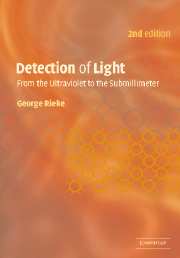Book contents
- Frontmatter
- Contents
- Preface
- 1 Introduction
- 2 Intrinsic photoconductors
- 3 Extrinsic photoconductors
- 4 Photodiodes and other junction-based detectors
- 5 Amplifiers and readouts
- 6 Arrays
- 7 Photoemissive detectors
- 8 Photography
- 9 Bolometers and other thermal detectors
- 10 Visible and infrared coherent receivers
- 11 Submillimeter- and millimeter-wave heterodyne receivers
- 12 Summary
- Appendices
- References
- Index
9 - Bolometers and other thermal detectors
Published online by Cambridge University Press: 09 November 2009
- Frontmatter
- Contents
- Preface
- 1 Introduction
- 2 Intrinsic photoconductors
- 3 Extrinsic photoconductors
- 4 Photodiodes and other junction-based detectors
- 5 Amplifiers and readouts
- 6 Arrays
- 7 Photoemissive detectors
- 8 Photography
- 9 Bolometers and other thermal detectors
- 10 Visible and infrared coherent receivers
- 11 Submillimeter- and millimeter-wave heterodyne receivers
- 12 Summary
- Appendices
- References
- Index
Summary
We now turn to thermal detectors, the second major class of detector listed in Chapter 1. Unlike all detector types described so far, these devices do not detect photons by the direct excitation of charge carriers. They instead absorb the photons and convert their energy to heat, which is detected by a very sensitive thermometer. The energy that the photons deposit is important to this process; the wavelength is irrelevant, that is, the detector responds identically to signals at any wavelength so long as the number of photons in the signal is adjusted to keep the absorbed energy the same. Thus, the wavelength dependence of responsivity is flat and as broad as the photon-absorbing material will allow. Because the absorber is decoupled from the detection process, it can be optimized fully, and quantum efficiencies can be as high as 90–100%. Bolometers based on semiconductor or superconductor temperature sensors are the most highly developed form of thermal detector for low light levels and are the detector of choice for many applications, especially in the submillimeter spectral range. They are also used as energy-resolving X-ray detectors. For the highest possible performance, such detectors need to be cooled to below 1 K. Bolometers manufactured by etching miniature structures in silicon and silicon nitride provide new possibilities for very high performance with large pixels and also for detector arrays.
- Type
- Chapter
- Information
- Detection of LightFrom the Ultraviolet to the Submillimeter, pp. 238 - 274Publisher: Cambridge University PressPrint publication year: 2002



